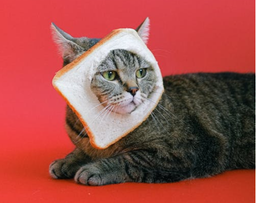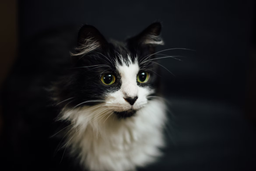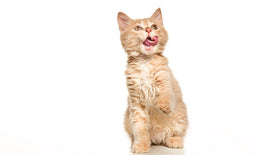Can cats eat chicken, and does poached poultry bring anything valuable to the table?
Domesticated felines come from a long line of predators whose natural diet consists predominantly of meat. As a general rule, you should tailor your pet’s meal plan to be as close to their ancestral feeding habits as possible.
When it comes to meat, it’s safe to say chicken is a staple food in most households. Crispy chicken strips make for top-tier sandwiches, but are they suitable for your feline companion? Can cats eat chicken, or are there certain dietary limitations you should consider? Let’s explore the pros and cons of chicken in your pet’s diet! We’ll also present the most delicious meals packed with animal protein and other bioavailable micronutrients necessary for your cat’s health.
Is chicken good for cats?
The short answer is yes! Poultry, in general, is rich in:
- Animal protein
- Natural minerals and vitamins
Your feline companion requires a high-protein diet to sustain their metabolic functions and maintain an active, healthy lifestyle. The protein in chicken will:
- Help your cat form muscle mass
- Keep their skin and fur healthy
High-quality chicken cuts and organs (e.g., chicken liver) are also filled with natural minerals and vitamins, mainly selenium, phosphorus, and vitamin B6. To find out why that’s important, check out the table below:
|
Micronutrient |
What it does for your cat |
|
Selenium |
Strengthens their immune response and reduces shedding and hairballs |
|
Phosphorus |
Sustains bone development, heart and liver function, and central nervous system health |
|
Vitamin B6 |
Improves kidney function and enables glucose release, preventing feline diabetes |
How about raw chicken? Is it safe for my pet?
Following the “cats are natural hunters” logic, you’d think raw food is a perfect meal, but that’s not entirely true. Unprocessed meat contains dangerous bacteria, such as salmonella, listeria, and E. coli, that are harmful to your cat. Unless it’s fresh prey (e.g., mice, insects, or birds cats naturally feed on in the wild), your pet should stay away from uncooked meals. Stick to serving commercial products that passed the mandatory safety checks or make home-cooked meals if you have the resources.
In case you give raw meat or eggs to your feline, pay close attention to the most common signs of bacterial infections:
- Diarrhoea
- High fever
- Nausea and vomiting
- Weight loss
- Dehydration
- Lethargy
If you suspect your cat has contracted bacteria, schedule an appointment with your vet immediately. Salmonellosis and listeriosis can have a lethal outcome when left untreated, so you need to act quickly.
Raw meat like chicken, fish, and beef is not the only potentially dangerous food item. Giving your cat fresh milk as a treat is a risky business frowned upon by veterinary experts. Unpasteurised dairy products contain the same harmful bacteria as raw meat and are rich in lactose, which can cause numerous digestive tract issues. Bar the occasional slice of Fromage du Chat or a bit of yoghurt, remove lactose from your cat’s diet altogether.
Can kittens eat chicken?
Before weaning, kittens get all their nutrients from breast milk, so there’s no need for dietary supplements. If their mother isn’t there to feed them, a kitten replacer formula (KMR) is the closest alternative.
Once a kitten is old enough to eat solid food, they require a well-balanced diet consisting of proteins, fats, and calcium. The nutrient ratio should look like this:
|
Nutrient |
Recommended amount |
|
Protein |
Over 50% |
|
Fat |
Up to 20% |
|
Calcium |
Less than 3% |
Protein is crucial for a feline’s development because it keeps them at a healthy weight and helps build muscle mass. So, can baby cats have chicken? If it’s well-cooked, unseasoned, and high-quality, then yes—kittens can eat poultry.
If you want to feed chicken to your growing cat, you’ll need to be extra careful. Since a kitten’s immune system is still developing, they’re susceptible to infections, so the risk of contraction, even through cross-contamination, is quite high.
Should you notice any symptoms of salmonellosis or listeriosis (diarrhoea, vomiting, and fever), take your kitten to the vet as soon as possible for further testing.
Feeding your cat chicken—choosing the “good parts”
Here’s a list of the most commonly used chicken parts and a brief description of why they’re (un)suitable for your cat:
- Main parts—The breast, wings, and drumsticks are considered the “good parts” because they’re tender and nutritious. If you want to feed your cat chicken, the best way is to gently boil the meat cuts and remove all the skin since it has an unhealthy fat content
- Giblets—Chicken liver makes for a healthy snack because it’s rich in proteins and vitamin A. Some caution is required since excessive consumption can cause several bone diseases, like osteoporosis and joint deformities. High amounts of specific minerals in giblets, especially the liver and kidneys, can lead to urinary tract disease (e.g., struvite crystals), hyperthyroidism, and kidney disease.
- Chicken bones—Giving your cat cooked chicken bones is a recipe for disaster! The brittle and hollow bones can split into tiny shards and get lodged in your pet’s throat. Even if they swallow it whole, the bone can still break in their stomach and cause severe internal damage. Some cat parents argue that raw bones are good for their pets’ teeth, but there are numerous safer alternatives
- By-products—Eggs or chicken by-products are not fit for feline consumption. Raw eggs can be especially harmful because they can contain dangerous bacteria and parasites

Chicken breast is the main course, but a slice of liver here and there will keep your cat healthy!
Image (c) Untamed
Can I feed my cat chicken every day?
Light meat is an excellent source of protein and minerals, but it doesn’t contain high amounts of other essential nutrients, most notably taurine (only 18 milligrammes per 100 grammes). Taurine is an amino acid that sustains your pet’s:
- Heart function
- Reproductive health
- Eyesight
Unlike humans, felines can’t produce enough taurine, which is why they must ingest it through their meals. Amino acid insufficiency can lead to a slew of health issues, so feeding your cat on home-cooked chicken only could have a negative effect in the long run. If you’re going to treat your cat to some chicken, it’s preferable to give them dark meat because of the higher taurine content.
Chicken breast is not particularly fatty. While that might fit nicely into your fitness goals, the feline energy requirements are quite different. Healthy fats are an invaluable energy source that shouldn’t be entirely replaced with lean protein or other nutrients.
Considering the overall nutritional value, chicken can be the basis of your cat’s diet, but you should mix various parts, including drumsticks and wings, to make healthy meals at home.
The question remains: how much chicken to feed a cat?
While it’s an excellent source of protein, the chicken breast shouldn’t be the only thing your cat consumes during the day. Ideally, the feline diet should follow cats’ natural feeding pattern while compensating for the elements it lacks. Commercial cat food (especially the canned variety) is manufactured to meet your cat's nutritional needs, meaning it contains loads of taurine, among other nutrients.
Yummy treats for the fussy feline
Some felines are fussy and may refuse to eat the same meal every day. As a cat parent, you must rise to the occasion and come up with delicious and nourishing treats.
In the table below, you’ll find some healthy meat snacks brimming with taurine:
|
Meat |
Taurine content per 100 grammes |
|
Scallops |
Up to 827 mg |
|
Mussels |
Up to 655 mg |
|
Clams |
Up to 520 mg |
|
Carp |
Up to 868 mg |
|
Tilapia |
Up to 927 mg |
|
Salmon |
Up to 94 mg |
|
Cod |
Up to 120 mg |
|
Tuna |
Up to 964 mg |
|
Turkey (dark meat) |
Up to 306 mg |
What about a vegetarian option? Should cats eat fruits and veggies? While your pet is far from being a vegan, they can take a liking to specific veggies and fruit. Here’s what’s safe:
- Apples
- Bananas
- Strawberries
- Seedless watermelon
- Berries
- Cantaloupe
- Pumpkin
- Carrots
- Asparagus
- Broccoli
- Cucumber
The fibre contents can help with digestive tract problems, such as constipation. Although a Pink Lady is a superior snack compared to chocolate, it still contains loads of sugar. Make sure fructose and vegetable fibre don't take up more than 2% of your pet’s diet.
You should also avoid giving your cat citrus fruit, grapes, and raisins because they’re known to cause kidney disease.
Looking for delicious and nutritious cat food? Try Untamed!
With Untamed, you won’t have to choose between aroma and nourishment. Our first-grade cat food is:
- High in protein—A single serving of Untamed food contains twice the amount of animal protein compared to the industry standard
- Vet-formulated—All our recipes are designed to fit your cat’s specific nutritional needs and are hypoallergenic
- Made with whole meats—Because Untamed products are made with human-grade whole meats, they’re easy on the stomach and highly nutritious
- Entirely ethical—We only use ethically-sourced ingredients for our meals and package all products in recyclable materials
- Paw-licking good—Is your cat stubborn and refusing to eat? Give them a whiff of Untamed food, and we guarantee they’ll come around
We believe your feline companion deserves the best, which is why we refuse to process our food heavily. Instead, all Untamed meals are gently steamed to retain the original nutritional value of the ingredients. Because of the unique preparation process, the health benefits of our cat cuisine are evident from day one.
After a few weeks of eating our tasty and nutritious recipes, your pet will have:
- Higher energy levels
- Regular bowel movement
- Fewer hairballs
- Shinier and thicker fur
- A healthy weight and lean physique
- An improved immune response
Our most pawpular chicken recipes
Here’s a taste of our most popular chicken recipes:
- Chocka Chicken in Gravy—A delicious dish for sensitive felines, made with hand-shredded chicken breast and steamed in natural gravy
- Chocka Chicken in Jelly—Extra moist chicken breasts soaked in jelly and light on the tummy
- Chocka Chicken with Ham in Gravy—Gently simmered chicken breast with a hint of ham to entice your feline’s sharp senses
- Chocka Chicken with Duck in Jelly—The ultimate poultry platter: high-quality chicken breast mixed with whole duck meat served in jelly
Take the Untamed online quiz and discover even more delicious meals waiting for your feline!

Chocka Chicken in Jelly will have your cat drooling the second you pop the lid!
Image (c) Untamed
Where can I get Untamed products?
All you have to do to get our tantalising dishes is take a brief online quiz to let us know about your cat’s:
- Age
- Food preferences
- Overall health
We offer a cat food trial pack with 12 delicious meals tailor-made for your feline companion! After a nine-day trial period, you can get monthly deliveries of personalised Untamed boxes at the same time every month, with no additional shipping fees.
We’re pretty confident our products will pass the taste test, but if not, you’re free to cancel or pause your cat food subscription whenever you want.

Interesting... I’ll have to have another bite, you know, to get all the flavours!
Image (c) Untamed
How to boil chicken for cats without giving them an upset tummy
Is boiled chicken good for cats? Steaming or simmering is the preferred preparation method for poultry and other meat. Not only does it improve the feline’s gastrointestinal motility, but it’s also quite appetising.
If you want to make a chicken dinner for your cat, here are some general guidelines on boiling chicken for cats:
- Fill a pan or a pot half full of water
- Remove all the skin and bones before cooking
- Place the meat in boiling water. Do not add any herbs or seasoning
- Cook or simmer at medium temperature
- Wait until the meat’s no longer pink, then remove it from the stove
- Leave it to cool at room temperature
- Check the temperature using a thermometer to confirm it’s safe for serving
- Shred it to smaller pieces and check for bones
Don’t throw away the water because it’s super nutritious. You can use it as cat broth or soup and serve it as a treat or to soften dry biscuits. Speaking of flavouring, do not add any vegetables or herbs you would typically use when preparing chicken. Your cat’s stomach is not designed to digest heavily seasoned food, so it’s best to keep it bland.
Some veggies essential for human health can be detrimental in feline meals. For example, the allium in chives, leeks, onions, and garlic can damage your cat’s kidneys and lead to several chronic conditions.

A watched pot never boils, so I might as well close my eyes for a moment. Wake me up when it’s time to lick the dishes!
Source: Pixabay
Commercial cat food—the ultimate feline diet?
Manufactured food is probably the best choice for a feline diet, at least when it comes to the pampered indoor cat. High-quality wet or semi-moist cat food is manufactured following a feline’s natural feeding regimen (minus the harmful pathogens in raw meat) and strict sanitary rules.
Canned food typically contains:
- Animal protein
- Healthy fats
- Vitamins and minerals
The moisture content also tends to be high (up to 78%), which is super important. Cats can get dehydrated because they don’t like drinking water from a bowl. The best way to keep them hydrated is to feed them wet food.
Because it’s high in protein and low in carbs, a wet food diet will keep your cat at a healthy weight, nourish their skin and fur, and reduce the risk of chronic illness.
Hold on, what about dry cat food?
Cat kibble is highly processed, so its nutritional value is lower. It’s often made with starch and grain, so dry cat food might be packed with carbohydrates. A tiny amount of healthy carbs can be a source of energy, especially for senior cats who tend to lose their vitality, but carbohydrates are not good for the feline metabolism.
A high-calorie diet can ultimately lead to:
- Severe dehydration
- Gastrointestinal issues
- Heart disease
- Diabetes
- Feline obesity
- Hypertension
- Urinary tract disease and kidney failure
- Food allergies (rare)
Cat kibble is not entirely bad, though. Most notably, dry cat food can be:
- A lot cheaper
- Good for dental health
Some vets claim dry biscuits can scrape the excess plaque off a cat’s teeth. The build-up can cause several dental diseases, such as gingivitis, which is why impeccable oral hygiene is a must. Sometimes animal bones are given for the same purpose, but that’s a huge health hazard.
Ultimately, biscuits work best when combined with top-notch wet food. The high moisture content of canned goods will keep your cat hydrated and well-nourished, while the rough texture will take care of their oral hygiene.
Check out our other guides to what cats can or cannot eat:
|
|

![Best food for Ragdoll cats in the UK [Broken Down]](http://untamed.com/cdn/shop/articles/featured_best_food_for_ragdoll_cats_uk.jpg?v=1646818249&width=256)

